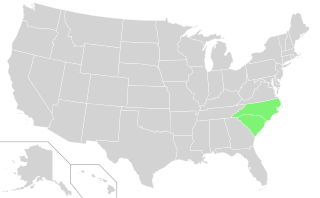
A Scottish clan is a kinship group among the Scottish people. Clans give a sense of shared identity and descent to members, and in modern times have an official structure recognised by the Court of the Lord Lyon, which regulates Scottish heraldry and coats of arms. Most clans have their own tartan patterns, usually dating from the 19th century, which members may incorporate into kilts or other clothing.

Tartan is a pattern consisting of criss-crossed horizontal and vertical bands in multiple colours. Tartans originated in woven wool, but now they are made in many other materials. Tartan is particularly associated with Scotland. Scottish kilts almost always have tartan patterns. Tartan is often called plaid in the United States, but in Scotland, a plaid is a tartan cloth slung over the shoulder as a kilt accessory, or a plain ordinary blanket such as one would have on a bed.

Clan MacLeod is a Highland Scottish clan associated with the Isle of Skye. There are two main branches of the clan: the MacLeods of Harris and Dunvegan, whose chief is MacLeod of MacLeod, are known in Gaelic as Sìol Tormoid ; the Clan MacLeod of Lewis and Raasay, whose chief is Macleod of The Lewes, are known in Gaelic as Sìol Torcaill. Both branches claim descent from Leòd, who lived in the 13th century.

Tartan Day is a North American celebration of Scottish heritage on April 6, the date on which the Declaration of Arbroath was signed in 1320. It originated in Canada in the mid-1980s. It spread to other communities of the Scottish diaspora in the 1990s. In Australia the similar International Tartan Day is held on July 1, the anniversary of the repeal of the 1747 Act of Proscription that banned the wearing of tartan.
The Royal Highland Fusiliers, 2nd Battalion, The Royal Regiment of Scotland is an infantry battalion of the Royal Regiment of Scotland.

An argyle pattern is made of diamonds or lozenges. The word is sometimes used to refer to an individual diamond in the design, but more commonly refers to the overall pattern. Most argyle contains layers of overlapping motifs, adding a sense of three-dimensionality, movement, and texture. Typically, there is an overlay of intercrossing diagonal lines on solid diamonds.
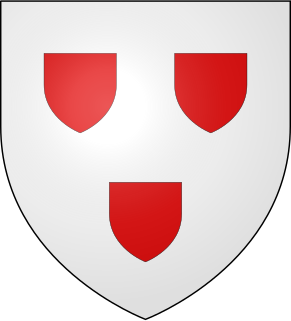
Clan Hay is a Scottish clan that has played an important part in the history and politics of Scotland. Members of the clan are to be found in most parts of Scotland and in many other parts of the world. However, the North East of Scotland, i.e. Aberdeenshire (historic), Banffshire, Morayshire and Nairnshire Nairn (boundaries), is the heart of Hay country with other significant concentrations of Hays being found in Perthshire, especially around Perth, in the Scottish Borders, and in Shetland.
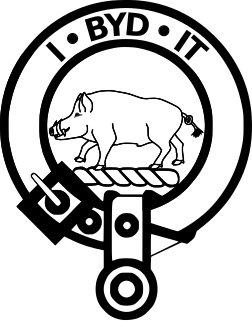
Clan Nesbitt is a Scottish clan of the Scottish Borders that is recognised by the Lord Lyon King of Arms.

The 78th Fraser Highlanders Pipe Band, is a pipe band from Campbellville, Ontario, Canada.

Clan Anderson is a Scottish clan that is recognized as such by the Lord Lyon King of Arms. However, as the clan does not currently have a chief recognized by the Court of the Lord Lyon, it is therefore considered an Armigerous clan. Variations of the surname are however considered septs of several other clans of the Scottish Highlands: The surname MacAndrews is considered a sept of the Clan Mackintosh and Clan Chattan, and also associated with the Clan MacDonell of Glengarry. The surnames Andrew and Andrews are considered septs of the Clan Ross.

The Scottish Tartans Authority (STA) is a Scottish-based organisation dedicated to promoting the knowledge of Scottish tartans. It was first formed in 1996 by former members of the Scottish Tartans Society. The organisation is dedicated to informing and educating the public about tartan, to facilitating research into tartan and Scottish heritage, to representing and supporting the businesses involved in the tartan sector and to maintaining the collection and library of tartan related artefacts, manuscripts and books.
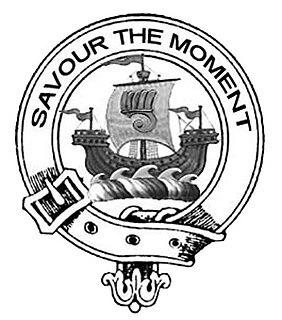
The personal name Duncan can be found in Scotland’s oldest records in its Gaelic form Dunchad/Donchadh/Donachie/Donnchadh and other spelling variants.

Clan MacAlister is a Scottish Clan and a branch of Clan Donald. The clan is the earliest branch to have split off from Clan Donald, claiming descent from Alasdair Mòr, son of Domhnall founder of Clan Donald. From Alasdair Mòr the clans takes its surname MacAlister; this surname is an Anglicisation of the Gaelic MacAlasdair meaning "son of Alasdair". In the 15th century the chief of the clan was seated in Kintyre, and the clan was centred there until the 18th century, when a chief sold the family estate in preference to a lowland estate.

Clan Arthur or Clan MacArthur, is a highland Scottish clan that once held lands on the shores of Loch Awe opposite Inishail. The clan has been described as one of the oldest clans in Argyll. Clan Arthur and Clan Campbell share a common origin, and at one point the MacArthurs challenged the seniority of the leading Campbell family. A branch of MacArthurs from the Isle of Skye were a sept of the MacDonalds of Sleat, and were hereditary pipers for the MacDonalds of the Isles. In late 18th century the chief of the clan died without an heir, leaving the clan leaderless until the late 20th century. In 2002, the first chief of Clan Arthur was recognised in about 230 years.

Border tartan, sometimes known as Northumbrian tartan, Shepherds' Plaid or Border Drab, or Border check is a design used in woven fabrics historically associated with the Anglo-Scottish Border, including the Scottish Borders and Northumbria. Possibly the most identifiable Border tartan garment of the region is the maud (plaid), made popular from the 1820s by fashionable Border Scots such as Sir Walter Scott, James Hogg, Henry Scott Riddell and Robert Burns.
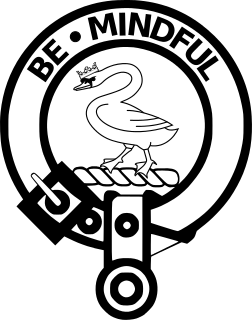
Clan Campbell of Cawdor is a highland Scottish clan and a branch of the larger Clan Campbell. While the clan is recognised by the Standing Council of Scottish Chiefs, the clan does not have a clan chief recognised by the Standing Council of Scottish Chiefs. Also, because the clan does not have a clan chief recognised by the Lord Lyon King of Arms it is considered an armigerous clan. The head of the Clan Campbell of Cawdor is the Earl Cawdor.

Clan Innes is a Highland Scottish clan. The clan is without a chief that is recognized by the Lord Lyon King of Arms; therefore it can be considered an armigerous clan. The clan takes its name from the lands of Innes in Moray, Scotland. Additionally, to avoid confusion - Clan Innes is not associated with Clan MacInnes which hails from Argyle and the western Isles.

Clan Little is a Scottish clan of the Borders. The clan does not currently have a chief and is therefore considered an armigerous clan. The Clan Little Society had a Guardian in place of a clan chief but, since his death in 2007, no suitable successor has appeared.



